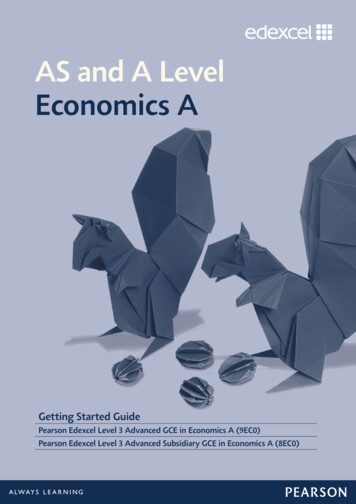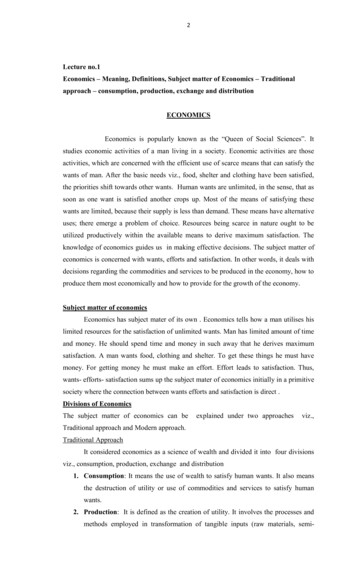
Transcription
AS and A LevelEconomics AGetting Started GuidePearson Edexcel Level 3 Advanced GCE in Economics A (9EC0)Pearson Edexcel Level 3 Advanced Subsidiary GCE in Economics A (8EC0)
Getting Started: AS and A levelEconomics AContents1. Introduction2. What’s changed?2.1 How have AS and A level changed?144Changes to AS and A level qualifications4Changes to subject criteria4Changes to Assessment Objectives2.2 Changes to the Pearson Edexcel AS and A level Economics Aspecifications67Specification overview7Changes to specification content9Changes to assessment3. Planning3.13.23.33.4Planning and delivering linear AS and A level coursesDelivery modelsCo-teaching AS and A levelSuggested resources4. Content guidanceIntroductionTheme 1: Introduction to markets and market failure1113131314141515151.1.1 Economics as a social science151.1.2 Positive and normative economic statements161.1.3 The economic problem161.1.4 Production possibility frontiers161.1.5 Specialisation and the division of labour171.1.6 Free market economies, mixed economy and commandeconomy181.2.1 Rational decision making181.2.2 Demand181.2.3 Price, income and cross elasticities of demand191.2.4 Supply211.2.5 Elasticity of supply221.2.6 Price determination221.2.7 Price mechanism231.2.8 Consumer and producer surplus241.2.9 Indirect taxes and subsidies241.2.10 Alternative views of consumer behaviour25
1.3.1 Types of market failure261.3.2 Externalities261.3.3 Public goods271.3.4 Information gaps271.4.1 Government intervention in markets271.4.2 Government failureTheme 2: The UK economy – performance and policies30312.1.1 Economic growth312.1.2 Inflation322.1.3 Employment and unemployment332.1.4 Balance of payments342.2.1 The characteristics of aggregate demand (AD)342.2.2 Consumption (C)352.2.3 Investment (I)352.2.4 Government expenditure (G)362.2.5 Net trade (X-M)362.3.1 The characteristics of AS362.3.2 Short-run AS372.3.3 Long-run AS372.4.1 National income382.4.2 Injections and withdrawals382.4.3 Equilibrium levels of real national output392.4.4 The multiplier392.5.1 Causes of growth392.5.2 Output gaps402.5.3 Trade (business) cycle412.5.4 The impact of economic growth422.6.1 Possible macroeconomic objectives432.6.2 Demand-side policies432.6.3 Supply-side policies452.6.4 Conflicts and trade-offs between objectives and policiesTheme 3: Business behaviour and the labour market46483.1.1 Sizes and types of firm483.1.2 Business growth483.1.3 Demergers493.2.1 Business objectives503.3.1 Revenue513.3.2 Costs523.3.3 Economies and diseconomies of scale523.3.4 Normal profits, supernormal profits and losses523.4.1 Efficiency533.4.2 Perfect competition54
3.4.3 Monopolistic competition563.4.4 Oligopoly573.4.5 Monopoly573.4.6 Monopsony603.4.7 Contestability613.5.1 Demand for labour623.5.2 Supply of labour623.5.3 Wage determination in competitive andnon-competitive markets633.6.1 Government intervention653.6.2 The impact of government interventionTheme 4: A global perspective65664.1.1 Globalisation664.1.2 Specialisation and trade674.1.3 Patterns of trade684.1.4 Terms of trade684.1.5 Trading blocs and the World Trade Organisation (WTO)694.1.6 Restrictions on free trade694.1.7 Balance of payments714.1.8 Exchange rates734.1.9 International competitiveness744.2.1 Absolute and relative poverty754.2.2 Inequality754.3.1 Measures of development774.3.2 Factors influencing growth and development784.3.3 Strategies influencing growth and development794.4.1 Role of financial markets814.4.2 Market failure in the financial sector824.4.3 Role of central banks824.5.1 Public expenditure824.5.2 Taxation834.5.3 Public sector finances854.5.4 Macroeconomic policies in a global context855. Assessment guidance5.15.25.35.4Implications of linear assessmentAS level assessmentA level assessmentQuestion types6. Quantitative skills6.1 Application of quantitative skills87878787889191
7. Transferable skills7.17.27.37.4The need for 21st century skillsCognitive skillsInterpersonal skillsIntrapersonal skills8. Economics and the EPQ9494949698100
1. Introduction1. Introduction1.1 Research and key principlesOur new AS and A level Economics specifications are designed to support a range ofstudent interests, learning styles and aspirations for progression.The specifications have been developed in consultation with the teachingcommunity, higher education, learned societies and subject associations. Teachersfrom a range of schools and colleges – in focus groups, surveys, phone interviewsand face-to-face conversations – have provided feedback at each stage and havehelped us to shape the specifications.Academics in UK universities have helped us understand how to build on thestrengths of the 2008 AS and A level Economics specifications and advised on howprogression to undergraduate study could be improved.We have commissioned and conducted our own research projects, includinginternational benchmarking. The specifications are also aligned with our World ClassQualification principles to ensure they are appropriate for a range of learners.Drawing on feedback from all parts of the Economics subject community, the 2015specifications have been designed to support students in developing the followingskills that have been identified as key for progression in this subject: Thinking like an economist. The application of economic concepts and theories to real-world contexts. The application of appropriate quantitative skills to relevant economic contexts. Engagement with economics through wider reading and an awareness of thecurrent issues impacting on the subject.The 2015 specifications have been built on the following key principles: Clear specifications. Clear guidance on what students need to learn,providing clarity for planning, teaching and assessments. The changes we havemade to the structure of the specifications are explained in Section 2.2, page 7. Co-teachable AS and A level courses. The AS level is embedded in theA level to allow co-teachability. The relationship between AS level and A levelqualifications and considerations for co-teaching the qualifications are detailedin Section 3 (page 13). Historical context and debate. The specifications select aspects of economichistory to inform macroeconomic debate and provide context to economicissues. This content is integrated throughout the themes and the courseoverview can be found on page 8. The rationale for including this new content isoutlined in the table on page 9. Reflect today’s global economy. Building on the strengths of The GlobalEconomy unit in the 2008 course, the new specifications ensure studentsdevelop an understanding of current global issues and development economics.The overview for the global theme can be found on page 8 and the changesmade to this theme (compared with the 2008 specification) are summarised inthe table on page 10. Mapping documents from the 2008 to 2015 specificationsare available on the Economics pages of the Edexcel website. Pearson Education Ltd 2014. This material is not copyright free.1
1. Introduction Reflect developments in economics. The specification content has beenupdated to reflect developments and current issues in economics. Theintroduction of the financial sector supports student understanding of recenteconomic events and the 2008 Global Financial Crisis. The inclusion of someintroductory ideas in behavioural economics ensures students develop anunderstanding of more recent economic thinking. A summary of these changescompared with our 2008 specification are summarised in the table on page 10.Ideas and suggestions for teaching approaches are detailed in Section 4 andfurther support for the new areas of the specification are available on theEconomics pages of the Edexcel website. Clear assessments. There is a clear and consistent use of command wordsacross assessments and between series. Our approach to the assessments,definitions for the command words and details of how the command wordsrelate to the assessments are explained in Section 5 on page 87. Real world focus. All of the assessments are based on real data and realissues. This helps provide stimulating assessment materials to cover a widerange of economic issues for students to engage with. For more informationabout how stimulus material is utilised in the assessments, see Section 5. Clear mark schemes. The new mark schemes provide a consistentunderstanding of the skills and connections between these skills required foreach question type. Clear wording reflects how teachers and examinersdescribe the qualities of student work, so the expectations are clear forteachers and for markers. Our approach to skills-based mark schemes isexplained in Section 5.6 on page 89. Skills for progression. Students will develop transferable skills to supportstudy in a wide range of subjects at university and the transition toemployment. These skills include numeracy, communication, critical thinking,forming and testing hypotheses and commercial awareness. Our approach toskills development is detailed in Section 5 (stimulus material), Section 6(quantitative skills), Section 7 (transferable skills) and Section 8 (economicsand the Extended Project Qualification).1.2 Support for the new specificationThis Getting Started guide provides an overview of the new AS and A levelspecifications to help you get to grips with the changes to content and assessment,and to help you understand what these changes mean for you and your students.We will be providing a package of support to help you plan and implement the newspecifications:2 Planning. In addition to the relevant section in this guide, we will be providinga course planner and scheme of work that you can adapt to suit yourdepartment. We will also be providing mapping documents to highlight keydifferences between the new and 2008 specifications. Teaching and learning. To support you with delivering the new specifications,we will be providing suggested resource lists, case studies and suggestedactivities, a student guide and materials for options evening. Understanding the standard. Exemplar student work with examinercommentaries for the sample assessment materials will be provided. Tracking learner progress. Our ResultsPlus service provides the mostdetailed analysis available of your students’ exam performance. It can help youidentify topics and skills where students could benefit from further learning.Extra assessment materials for A level will also be available (from spring 2015)to support formative assessment. Pearson Education Ltd 2014. This material is not copyright free.
1. Introduction Support. Our subject advisor service, led by Colin Leith, and online communitywill ensure you receive help and guidance from us as well as sharing ideas andinformation with each other. You can sign up to receive e-newsletters fromColin to keep up-to-date with qualification updates, and product and servicenews.These support documents will be available on the Economics pages of theEdexcel website. Pearson Education Ltd 2014. This material is not copyright free.3
2. What’s changed?2. What’s changed?2.1 How have AS and A level changed?Changes to AS and A level qualificationsFrom September 2015, A level Economics A will be a linear qualification.This means that all examinations must be sat at the end of the course.More information about the implications of the move to linear assessment is givenin Section 3 on page 13.From September 2015, AS level Economics A will be a standalone qualification.This means that it cannot be used to contribute towards an A level grade.More information about the relationship between AS and A level is given inSection 3 on page 13.Changes to subject criteriaThe subject content requirements for AS and A level Economics have been revised.All awarding organisations’ specifications must meet these criteria. The full subjectcontent document can be found on the Department for Education website, but theboxes below highlight the key requirements.The following requirements apply to both AS and A level Economics specifications:AS and A level specifications must require students to:4 develop an understanding of economic concepts and theories through acritical consideration of current economic issues, problems and institutionsthat affect everyday life develop analytical and quantitative skills in selecting, interpreting and usingappropriate data from a range of sources, including those in the Annex explain, analyse and evaluate the strengths and weaknesses of the marketeconomy and the role of government within it develop a critical approach to economic models of enquiry, recognising thelimitations of economic models understand microeconomic and macroeconomic market models; use themodels to explore current economic behaviour; make causal connections;and develop an understanding of how the models shed light on the economyas a whole be aware of the assumptions of the model of supply and demand; explain theway it works using a range of techniques; and use the model to describe,predict and analyse economic behaviour develop an understanding of the benefits of markets and the reasons whythey may fail; understand the implications of market failure for individuals,firms and government, and recognise the possibility of government failure use the aggregate demand/aggregate supply (AD/AS) model and data tounderstand why supply-side and/or demand-side policies may be seen asappropriate ways of managing an economy consider the possible impact of macroeconomic policies; recognise the issuesgovernment faces in managing the macroeconomy; argue for differentapproaches; and identify criteria for success and evaluate effectiveness develop the ability to apply and evaluate economic models as represented inwritten, numerical and graphical forms; interpret and evaluate different typesof data from multiple sources; and propose and justify possible responses toeconomic issues. Pearson Education Ltd 2014. This material is not copyright free.
2. What’s changed?All AS and A level specifications must cover the following core knowledge,understanding and skills:Economic choices and markets Scarcity and choice: the basic economic problem, opportunity cost,specialisation and trade. How competitive markets work: allocation of resources, the objectives ofeconomic agents, supply and demand, elasticity. Market failure and government intervention: externalities, alternativemethods of government intervention, government failure.The national and global economy The determination of output, employment and prices: circular flow of income,expenditure and output, aggregate demand and aggregate supply. Economic policy objectives and indicators of macroeconomic performance: forexample, economic growth, employment, inflation, the balance of payments;potential policy conflicts and trade-offs. The global context: international trade, exchange rate changes. The application of policy instruments: the nature and impact of fiscal,monetary, exchange rate and supply-side policies.The following requirements also apply to A level Economics specifications:A level specifications must require students to: develop an understanding of the role and impact of the financial sector recognise the assumptions, relationships and linkages of the possible impactsof macroeconomic policies apply and evaluate economic concepts, theories, methods and models to awider range of contexts.A level specifications must also cover the following core knowledge,understanding and skills:Economic choices and markets Scarcity and choice: the margin. How competitive markets work: productive and allocative efficiency, theinteraction of markets. Competition and market power: business objectives, market structures andtheir implications for the way resources are allocated, interdependence offirms. Labour market: wage determination, labour market issues, governmentintervention. Market failure and government intervention: market power, informationasymmetries.The national and global economy Financial sector: the role of the financial sector and its impact on the realeconomy, financial regulation, role of central banks. Economic policy objectives and indicators of macroeconomic performance:income distribution and welfare. The global context: globalisation, trade policies and negotiations. Pearson Education Ltd 2014. This material is not copyright free.5
2. What’s changed?The main changes in the revised subject content are: the core content requirements (outlined in the tables on page 5) mustconstitute 60% of the AS and A level specification content there is defined core content for AS level the inclusion of the financial sector and labour markets within the core contentfor A level there is greater emphasis on the application of appropriate quantitative skills ina range of economic contexts. The assessment of these skills will include atleast level 2 mathematical skills as a minimum of 15% of the overall AS and20% of the overall A level marks.Students are expected to accomplish the following quantitative skills as part of theirAS and A level study: calculate, use and understand ratios and fractions calculate, use and understand percentages and percentage changes understand and use the terms mean, median and relevant quantiles construct and interpret a range of standard graphical forms calculate and interpret index numbers calculate cost, revenue and profit (marginal, average, totals) make calculations to convert from money to real terms make calculations of elasticity and interpret the result interpret, apply and analyse information in written, graphical and numericalforms* skills in bold are not a requirement in the AS level.More information about the application of quantitative skills is given in Section 6.Changes to Assessment ObjectivesThe AS and A level Economics Assessment Objectives have been revised.The objectives have been made more explicit to exemplify the skills developedthrough the AS and A level specifications. The Assessment Objectives are the samefor both AS and A level but the weightings are different.AO1AS 25–35%A level 20–30%AO2AS 25–35%A level 20–30%AO3AS 15–25%Demonstrate knowledge of terms/concepts andtheories/models to show an understanding of the behaviourof economic agents and how they are affected by andrespond to economic issuesApply knowledge and understanding to various economiccontexts to show how economic agents are affected by andrespond to issuesAnalyse issues within economics, showing an understandingof their impact on economic agentsA level 20–30%AO4AS 15–25%A level 20–30%6Evaluate economic arguments and use qualitative andquantitative evidence to support informed judgementsrelating to economic issues Pearson Education Ltd 2014. This material is not copyright free.
2. What’s changed?2.2 Changes to the Pearson Edexcel AS and A levelEconomics A specificationsThe A level specification is structured into four themes. In this structure studentsare introduced to core economic concepts and principles and develop anunderstanding of microeconomic and macroeconomic issues, before building on thiscore knowledge and understanding to consider more complex issues and widercontexts. In this thematic approach, progression is continuous as students developtheir knowledge and understanding throughout the course of study.Students use economic models to help them understand the complexities of theworld around them, and use data to help them analyse markets and economies,and how governments try to influence both. Students are introduced to differentperspectives, aspects of economic history and develop an understanding ofeconomic issues.In developing the 2015 specifications we have retained the strengths of the 2008specification: Engaging and updated content Development economics Global focus AS and A level courses designed to allow co-teachabilityThe layout of the specification content has changed to make clear what studentsneed to learn. The guidance column has been removed and the contentrequirements are detailed in the main content columns.Changes have been made to the specification content and the assessments toensure the revised subject content and assessment requirements for economics aremet (as outlined in Section 2.1), and to bring the specification up-to-date(see page 9).Specification overviewThe A level qualification is structured into four themes, with two microeconomic andtwo macroeconomic themes. The content is structured coherently and logically,which enables students to build on their knowledge and understanding as theyprogress throughout the course – students are introduced to economics throughbuilding knowledge and application of microeconomic and macroeconomic conceptsin Theme 1 and Theme 2, with breadth and depth of knowledge and understanding,and applications to more complex concepts and models developed in Theme 3 andTheme 4. This division between microeconomic and macroeconomic themes alsosupports teacher specialism and ensures the specification is deliverable for twoteaching specialists.The charts on page 8 provide an overview of the A level and AS level specifications,indicating the relationship between the two. (Further guidance on the relationshipbetween AS and A level is provided in Section 3 on page 13.) Pearson Education Ltd 2014. This material is not copyright free.7
2. What’s changed?The A level is structured into four themes with three externally assessed exams:Theme 1Introduction to markets and marketfailureTheme 2The UK economy – performanceand policies1.1 The nature of economics2.1 Measures of economic performance1.2 How markets work2.2 Aggregate demand1.3 Market failure2.3 Aggregate supply1.4 Government intervention2.4 National income2.5 Economic growth2.6 Macroeconomic objectives andpolicyTheme 3Theme 4Business behaviour and the labourmarketA global perspective3.1 Business growth4.1 International economics4.2 Poverty and inequality3.2 Business objectives3.3 Revenues, costs and profit4.3 Emerging and developingeconomies3.4 Market structures4.4 The financial sector3.5 The labour market4.5 Role of the state in themacroeconomy3.6 Government interventionPaper 1Markets and business behaviourAssessing Theme 1 and Theme 3Paper 2The national and global economyAssessing Theme 2 and Theme 4Paper 3Microeconomics and macroeconomicsAssessing all themesThe AS level is embedded in the A level: Theme 1 and Theme 2 comprise the samecontent for both the AS and A level specifications. There are two externallyassessed exams:Theme 1Introduction to markets and marketfailureTheme 2The UK economy – performanceand policies1.1 The nature of economics2.1 Measures of economic performance1.2 How markets work2.2 Aggregate demand1.3 Market failure2.3 Aggregate supply1.4 Government intervention2.4 National income2.5 Economic growth2.6 Macroeconomic objectives andpolicyPaper 1Introduction to markets and marketfailure8Paper 2The UK economy – performanceand policies Pearson Education Ltd 2014. This material is not copyright free.
2. What’s changed?Changes to specification contentChanges have been made to the specification content, both to ensure the revisedsubject content requirements for economics are met and to refresh thespecifications to bring them more up-to-date in response to our research findings;for example, by incorporating current issues such as some introductory ideasrelating to behavioural economics.The following content has been included in addition to the core content specified inthe DfE subject criteria (outlined on pages 4-5). The content outlined in the tablebelow has been included to enable students to build on the core contentrequirements to ensure sufficient depth, and to include additional subject content toensure sufficient breadth.Specification contentRationale for inclusionThe nature of economicsThis introductory content addresses the aimsand objectives with regards to appreciating thecontribution of economics, developing an abilityto think as an economist and understandingthat economic behaviour can be coveredthrough a range of perspectives.Rational decision making andalternative views of consumerbehaviourThis content addresses the requirement fromstakeholders to include an element ofbehavioural economics and ensure thespecification includes up-to-date andcontemporary issues in the subject area.Economic history and economicthinkersAspects of economic history have beenintegrated throughout the course to supportcontextual awareness and informmacroeconomic debate. The contentdemonstrates how economic events can beinterpreted in different ways and how theyimpact on more recent economic events.The inclusion of reference to economic thinkerssupports the understanding that there aredifferent perspectives in economics, withdifferent ways of approaching economic issues.References to current economic policies andissues, and the requirement to develop anawareness of recent events are outlined in thespecification.Emerging and developingeconomies (in Theme 4)Theme 4 focuses on macroeconomics in theglobal context, with particular reference toemerging and developing economies. Thisdemonstrates how economic concepts andtheories can be applied in different and realworld contexts. Pearson Education Ltd 2014. This material is not copyright free.9
2. What’s changed?The table below is an overview of the main changes in content from our 2008specification. More detailed mapping of individual topics from the 2015 specificationto the 2008 specification can be found on the Economics pages of the Edexcelwebsite.2015 specification contentChanges from 2008specificationTheme 1Introduction to markets and marketfailure1.1 The nature of economics1.2 How markets work1.3 Market failureInclusion of an awareness ofeconomic thinkers with reference toSmith, Hayek and Marx.Inclusion of rational decision makingand alternative views of consumerbehaviour – an introduction tobehavioural economics.1.4 Government interventionTheme 2The UK economy – performance andpolicies2.1 Measures of economic performance2.2 Aggregate demand2.3 Aggregate supply2.4 National incomeSelected aspects of economic historyfor context, with the inclusion ofKeynes and references to andawareness of different interpretationsof and policy responses to the GreatDepression and the Global FinancialCrisis.Inclusion of national happiness as ameasure of wellbeing.2.5 Economic growth2.6 Macroeconomic objectives and policyTheme 3Business behaviour and the labourmarketCoverage of the labour market in thistheme.3.1 Business growth3.2 Business objectives3.3 Revenues, costs and profit3.4 Market structures3.5 The labour market3.6 Government interventionTheme 4Inclusion of a topic on the financialsector covering the role of financialmarkets and central banks, functionsof money and market failure in thefinancial sector.A global perspective4.1 International economics4.2 Poverty and inequality4.3 Emerging and developing economies4.4 The financial sector4.5 Role of the state in themacroeconomy10 Pearson Education Ltd 2014. This material is not copyright free.
2. What’s changed?Changes to assessmentThe assessment structures for the AS and A level qualifications are outlined belowand on page 12. More detail on the assessment for each component is given inSection 5 on page 87.There are three A level papers, each comprising 100 marks and 2 hours induration.Paper 1Markets and businessbehaviourTotal marks: 100Weighting: 35%Section A: Multiple-choice and short-answerquestions. Students answer all questions.Section B: Based on stimulus material.One data response question comprising anumber of parts.Exam time: 2hrsQuestions drawn from Theme 1and Theme 3 content.Paper 2The national and globaleconomyTotal marks: 100Weighting: 35%Exam time: 2hrsQuestions drawn from Theme 2and Theme 4 content.Paper 3Microeconomics andmacroeconomicsTotal marks: 100Section C: One extended open-responsequestion. Students select one from a choiceof two.Section A: Multiple-choice and short-answerquestions. Students answer all questions.Section B: Based on stimulus material.One data response question comprising anumber of parts.Section C: One extended open-responsequestion. Students select one from a choiceof two.Section A: Based on stimulus material.One data response question comprising anumber of parts, including one extendedopen-response question (students select oneextended open-response question from achoice of two).Weighting: 30%Exam time: 2hrsQuestions drawn from all themes.Section B: Based on stimulus material.One data response question comprising anumber of parts, including one extendedopen-response question (students select oneextended open-response question from achoice of two). Pearson Education Ltd 2014. This material is not copyright free.11
2. What’s changed?There are two AS level papers, each comprising 80 marks and 1.5 hoursin duration.Paper 1Introduction tomarkets and marketfailureTotal marks: 80Weighting: 50%Exam time: 1hr 30Questions are drawnfrom Theme 1 contentPaper 2The UK economy –performance andpoliciesTotal marks: 80Weighting: 50%Exam time: 1hr 30Questions are drawnfrom Theme 2 contentSection A: Multiple-choice and short-answerquestions.Students answer all questions.Section B: Based on stimulus material.One data response question comprising a numberof parts, including one extended open-responsequestion (students select one extended open-responsequestion from a choice of two).Section A: Multiple-choice and short-answerquestions.Students answer all questions.Section B: Based on stimulus material.One data response question comprising a numberof parts, including one extended open-responsequestion (students select one extended open-responsequestion from a choice of two).Changes have been made to the approach of the AS level and A level papers toensure the assessments are clear and consistent, enabling students to understandthe skills they are required to demonstrate and not overly focus on examtechnique. The changes summarised be
This Getting Started guide provides an overview of the new AS and A level specifications to help you get to grips with the changes to content and assessment, and to help you understand what these changes mean for you and your students. We will be providing a package of support to help you plan and implement the new specifications: Planning.











